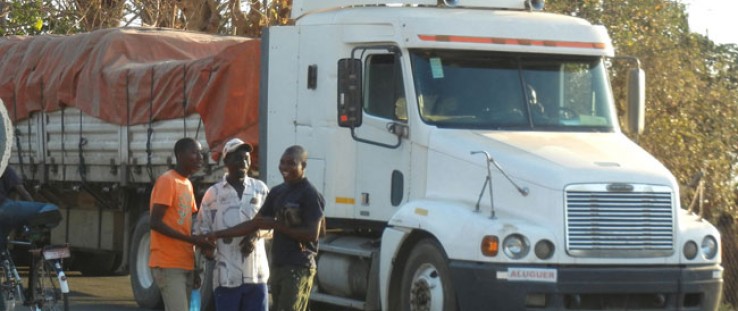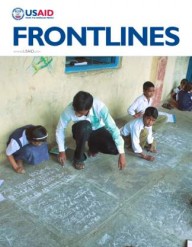 USAID is helping to reduce border delays for traders. Pictured: The Mwanza-Sobue Border Post, Malawi-Mozambique.
USAID SOUTHERN AFRICAN TRADE HUB
USAID is helping to reduce border delays for traders. Pictured: The Mwanza-Sobue Border Post, Malawi-Mozambique.
USAID SOUTHERN AFRICAN TRADE HUB
 USAID is helping to reduce border delays for traders. Pictured: The Mwanza-Sobue Border Post, Malawi-Mozambique.
USAID SOUTHERN AFRICAN TRADE HUB
USAID is helping to reduce border delays for traders. Pictured: The Mwanza-Sobue Border Post, Malawi-Mozambique.
USAID SOUTHERN AFRICAN TRADE HUB
Everyone intuitively understands the problems that arise when fresh fruit imports destined for the marketplace sit on a wharf awaiting clearance by customs officials. If border control agencies don’t carry out their duties in a timely fashion, the fruit rots and loses its commercial value.
All countries, but especially land-locked ones like Rwanda, suffer when their perishable imports or exports are delayed at the border. When exporting coffee, for example, a Rwandan producer must rely on the efficiency of neighbors in either Tanzania or Kenya to move the coffee quickly across borders so it can be shipped fresh to world markets.
What many people may not fully appreciate is that non-perishable goods are also affected by border delays. Though manufactured goods and other items may not deteriorate, they still cost their traders if customs stalls in clearing them for the domestic market. The same Rwandan coffee producer may see his costs rise as he’s forced to wait for packaging material he ordered from overseas so his small business can export the coffee.
These are the kinds of roadblocks that USAID’s Partnership for Trade Facilitation is designed to remove. It is an effort by USAID and other international donors to improve the international movement of goods by working directly with the affected countries. Launched in November 2011, the partnership builds on negotiations taking place in Geneva under the auspices of the World Trade Organization that also are designed to improve the flow of goods around the world.
USAID plans to assist more than a dozen countries in several regions to meet their trade goals, including Rwanda, Mozambique, Guatemala, the Philippines and Vietnam.
ABCs of Trade Facilitation
Trade facilitation is known as the “plumbing” of international trade. It is not sexy, but it is crucial to world economies, particularly for developing countries that struggle to engage effectively with the international trading system.
“Trade facilitation looks at how procedures and controls governing the movement of goods across national borders can be improved to reduce associated cost burdens and maximize efficiency while safeguarding legitimate regulatory objectives,” said Virginia Brown, director of USAID’s Office of Trade and Regulatory Reform.
More simply, trade facilitation’s twin goals are to reduce transaction costs while maintaining efficiency and control. And, as the saying goes, time is money.
Barriers to the movement of goods across borders cost businesses plenty, reducing the benefits of economic growth. A day’s delay means higher costs for producers, shippers and buyers. A 2007 study found that each day in transit for goods such as vegetables and fruit is equivalent to lowering their prices by 0.9 percent. Another study from 2009 found that in sub-Saharan Africa, a 10 percent reduction in exporting costs increased exports by 4.7 percent.
“When customs authorities are inefficient and the clearance of goods takes longer than it should, the economic costs for all involved in a transaction can be significant,” said Brown. “Fewer constraints at a border leads to more trade.”
Rwanda Leaps Trade Hurdles
Bernard Mulindabigwi, a Rwandan trader for the company AZ Impex, has faced these frustrations firsthand. “I have been dealing with the importation of car spare parts and generators for the last 17 years,” he explains. “During this time, I have encountered problems in the clearance of goods as there has been no channel for challenging any decision made by customs.”
Worse, he often has no idea why the process is delayed. “The customs officer told me that clearance is pending further investigations, but I have no idea what is actually being investigated, why cargo is held, or for how long,” says Mulindabigwi. “If authorities delay clearance, it is difficult to challenge decisions made by customs and the process can be frustrating.”
The Government of Rwanda has made great strides in modernizing customs procedures. Still, much remains to be done.
Rwanda ranks 155 out of 180 on the “Trading Across Borders” indicator of the World Bank’s Doing Business 2012 Report, which measures the time and cost for exporting and importing. Traders typically must comply with cumbersome regulatory requirements, ranging from obtaining certificates or permits to undertaking complicated formalities required by different border control agencies.
USAID’s Partnership for Trade Facilitation was launched in Rwanda in August 2012 and will provide technical support to Rwanda’s border agencies to rework their regulations regarding the flow of goods across the country’s borders.
In doing so, the Agency is building upon decades of U.S. expertise in helping poor countries reduce barriers to commerce. USAID assistance to a number of developing countries has contributed to substantial reductions in the time to export over the past five years. Doing Business shows reductions from 24 days to 13 days in Jordan, 22 days to 14 days in El Salvador, 34 days to 14 days in Colombia, and 60 to 44 days in Zambia.
In East Africa, a USAID-supported software platform implemented in 2010 allows customs officials to communicate across borders. As a result, the time required to transport goods along the Mombasa-Kigali trade corridor decreased by five days. The cost of trading goods in the region decreased by 2 percent, despite a 19 percent increase in fuel prices.
This information, and the increased certainty that it brings, will enable firms like AZ Impex to anticipate import costs critical to making a profit. Similarly, with a transparent appeals process in place, traders will have an avenue to formally appeal customs decisions through a proposed independent appeals tribunal. According to Mulindabigwi, though this process is long overdue, these reforms will make customs procedures much more transparent.
Improving trade facilitation is an ongoing process entailing numerous interventions in various areas. USAID’s assistance through the Partnership for Trade Facilitation is only part of the puzzle. Challenges include insufficient energy and transportation infrastructure—roads, rail and air—that link to international markets. Brown concedes that money for large infrastructure projects is limited, but says that USAID, by focusing on “soft infrastructure,” can make a meaningful impact.
With greater predictability about how governments manage border operations, businesses will face fewer delays and lower costs, ultimately benefitting a country’s economic prospects and people.
AFRICAN TRADE HUBS
At the regional level, USAID has helped to advance cross-border integration and boost intra- and extra-regional trade primarily through three trade hubs located in Botswana, Ghana and Kenya, for Southern, West and East Africa, respectively. These hubs have implemented innovative initiatives to reduce both legal and illicit bottlenecks along major trade corridors, and to establish single-border posts and computerized customs procedures.
PARTNERSHIP FOR TRADE FACILITATION COUNTRIES
- Cambodia
- Colombia
- El Salvador
- Grenada
- Guatemala
- Honduras
- Jordan
- Laos
- Mozambique
- Namibia
- Peru
- Philippines
- Rwanda
- Vietnam









Comment
Make a general inquiry or suggest an improvement.